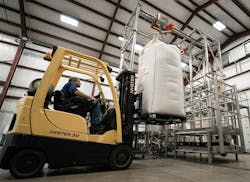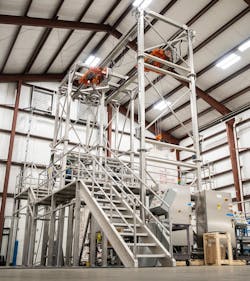Properly implementing bulk material handling equipment can significantly improve material flow, providing a smooth and continuous flow of materials that reduces bottlenecks and minimizes production downtime, resulting in a more streamlined operation and improved productivity. If selected correctly and with the incorporation of key safety features, bulk material handling systems can help mitigate the risk of accidents or injuries in industrial settings, creating a safer working environment for operators.
When working with an equipment supplier to conceptualize and design a system for integration into your facility, be sure to consider the following 10 key factors.
1. What materials will you be handling?
The material characteristics of bulk solids play an essential role in the design and operation of bulk material handling systems. Understanding a material’s properties, such as particle size, bulk density, moisture content and flowability, is essential for selecting the appropriate equipment and designing a system that can handle the material effectively. For example, a highly abrasive material can cause premature wear to equipment and result in increased maintenance costs. Similarly, a material that is highly cohesive or prone to bridging can cause flow problems and blockages in the system. By analyzing the material characteristics, engineers can determine the appropriate equipment and system layout to ensure efficient and safe material handling.
2. What is the required volume and throughput?
Volume and throughput are essential factors to consider in bulk material handling system design because they determine the required system capacity and the efficiency with which materials will be conveyed. The volume of material that needs to be transported or stored will determine the size of equipment such as conveying systems or storage vessels. Throughput, or the rate at which materials will be moved through the system, is essential for determining the speed at which materials are to be processed and the downtime necessary for maintenance or repairs. Both of these factors require careful consideration to design an effective and efficient bulk material handling system.
3. What other material handling equipment types are required?
Bulk handling systems often involve various equipment to move and efficiently process materials. Some standard pieces of equipment used in bulk handling systems include pneumatic conveying systems, belt conveyors, bucket elevators, screw conveyors, feeders, silos, hoppers and chutes. Each of these components plays a specific role in the overall design, helping to transport materials between various processing stages while minimizing the risk of damage or loss. Ensuring that the equipment supplier has manufacturing capabilities to produce these pieces of equipment or partnerships with reputable manufacturers is critical for optimal system design.
4. What type of environment will the system operate within?
Materials that generate dust and airborne particulates require a sealed system with robust air filtration to maintain air quality for operators working closely with the equipment. For chemical processing operations, systems can be designed using corrosion-resistant materials, which could include special alloys, plastics or protective coatings. Systems that will be installed in hazardous locations (areas classified for combustible dust, gases or vapors) must be designed to comply with applicable electrical codes and safety standards.
5. Will space constraints impact the system's design?
Space constraints can have a significant impact on bulk material system designs. Engineers must consider the available space and how to utilize it efficiently, including determining the necessary clearance for equipment, such as conveyors and storage vessels, and accounting for any obstacles that may impede material flow. In some cases, it may be necessary to install equipment vertically or consider alternative layouts to optimize space usage. Additionally, space constraints can affect a system’s capacity, as the available space may limit the amount of material that can be stored or processed at any given time. Therefore, it is vital for engineers to carefully consider space constraints when designing bulk material systems to ensure efficient and effective operation.
6. How will the new system design integrate with existing systems?
When designing a new bulk handling system, careful evaluation of the existing equipment and how it can be effectively integrated into the design is crucial. By assessing the condition and capacity of existing equipment, as well as ensuring its compatibility with any new equipment being added, engineers can optimize the design for efficiency and cost-effectiveness. Furthermore, modifications or upgrades to existing equipment may be necessary to meet the new system's requirements.
7. What type of automation and control systems are required?
Automation and control systems are essential for bulk handling system design. These systems allow for the seamless and efficient operation of the equipment, reducing the risk of errors and increasing productivity. Automation and control systems can monitor and adjust the system in real time, allowing for quick and effective reactions to any issues. This ensures the safety of the system and its operators. Moreover, these systems can collect and analyze data to identify areas for improvement, allowing for continuous optimization of the system. Lastly, automation and control systems can also reduce operating costs by minimizing energy consumption and reducing the need for manual labor.
8. What are the cost considerations?
Cost is a significant consideration in bulk material handling system design, as it can considerably impact the project's feasibility. Carefully evaluate the cost of equipment, installation and ongoing maintenance to ensure that the system is cost-effective and provides a strong return on investment. Additionally, engineers must consider the cost of downtime, repairs and replacement parts that may be required over the system's life. By considering these factors, engineers can design a system that meets the project's budget while providing the necessary capacity, throughput and safety features. It is important to note that choosing an equipment supplier with added value programs such as discounted parts, continued maintenance guidance, and onsite support should be considered during the planning phase.
9. What training and human resources will be required to implement the new handling system effectively?
Systems require skilled operators and maintenance personnel for safe and efficient operation. Proper training is essential for workers to learn how to operate the equipment, troubleshoot issues and maintain the system. A well-designed training program can reduce downtime, increase productivity and improve safety. Additionally, having a competent and well-trained maintenance team can help identify and prevent equipment failures, reducing the risk of accidents and costly repairs. Therefore, factoring in training and human resources when designing a bulk material handling system is crucial.
10. Will the system design require future scalability allowance?
Scalability is essential when designing bulk material handling systems because it ensures that the system can adapt to changing production needs over time. By considering scalability during the design phase, engineers can anticipate future production growth and design a system that can be easily expanded or modified without requiring significant downtime or costly system replacements. Not only does this ensure that the system can keep up with production demands over time, it also provides greater flexibility and reduces the risk of production disruptions. Additionally, a scalable system can help reduce costs associated with future upgrades or expansions, as the system can be designed to incorporate additional equipment and capacity as needed.
The complexity of designing, installing and maintaining bulk material handling systems requires specialized knowledge and expertise. A good supplier should also be a system integrator with experience in various applications, technologies and equipment and the ability to develop a customized solution that meets the application’s specific production goals or challenges. Longevity and optimal performance are key. System integrators can also provide ongoing support with a maintenance plan to keep production output high and unnecessary production downtime low.
Choosing the right system integrator can minimize the risk of costly errors, delays and downtime and ensure that your investment delivers the expected ROI.
Material Transfer
www.materialtransfer.com




